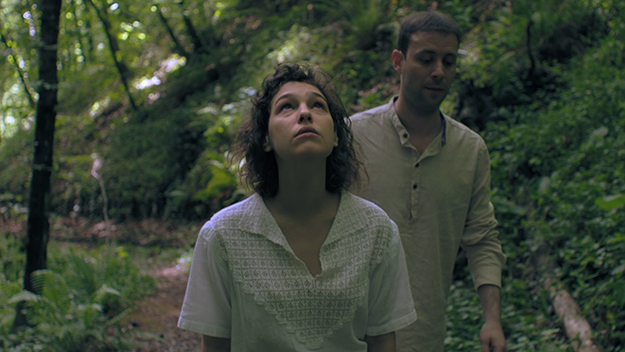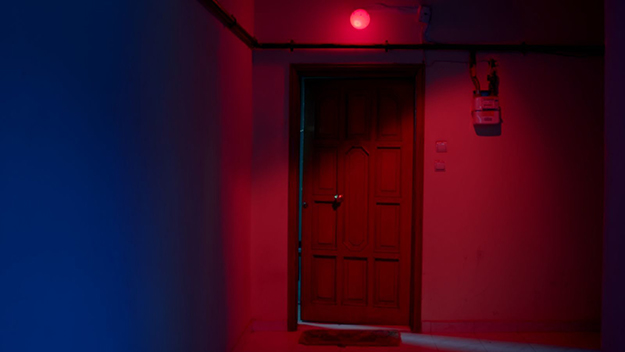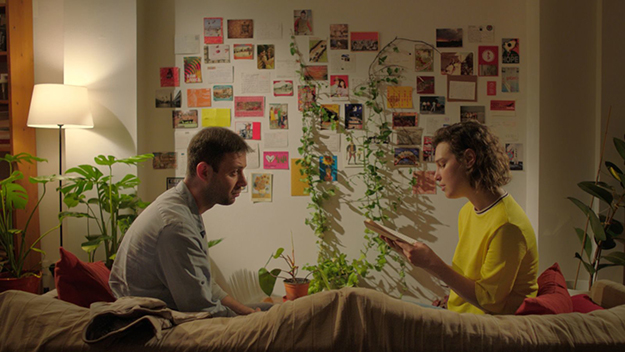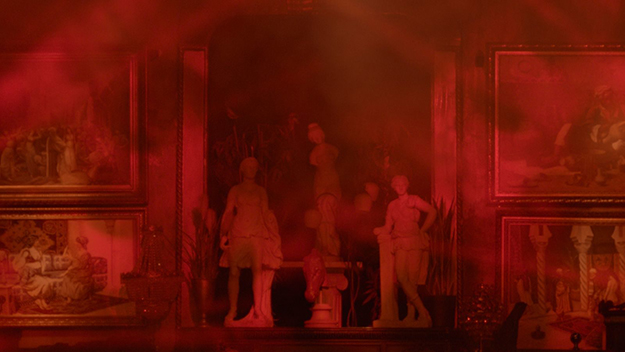Interview: Burak Çevik

Last year in the May/June issue, I wrote about Burak Çevik’s debut The Pillar of Salt, an elliptical narrative of a pregnant vampire emerging from a cave in search of her urbanite twin sister: “Infused with an apocalyptic atmosphere that draws as much from ’70s visceral horror as from the slow-burning, contemplative cinemas of Tsai Ming-liang and Apichatpong Weerasethakul, 24-year-old first-time feature filmmaker Burak Çevik’s Berlinale Forum entry The Pillar of Salt is an engrossingly imaginative dystopian meditation on the fractured and paranoid nature of contemporary Turkish reality.” Çevik’s second feature, Belonging, continues his existential explorations through the story of a crime committed on Istanbul’s outskirts.
Over the opening black screen, the director reveals in voiceover that the film has autobiographical origins in his grandmother’s murder by his aunt and her lover a decade and a half prior. Composed of shots of empty places set to an ominous ambient score, the first half presents a detailed account of events borrowed from the male accomplice’s statement to the police. A leap into fiction and fantasy, the second half subverts our expectations by depicting the youthful innocence of the night the couple crossed paths. Driven by a belief in cinematic language, Belonging is a therapeutic gesture that rises above psychological and moral judgments to navigate the complexity of family history.
I spoke with Çevik over Skype in advance of Belonging’s U.S. premiere on April 4 in New Directors/New Films.
Why did you choose to focus on the how of the killing rather than the why?
I’ve always thought that when we talk about films, we should separate them from their directors and consider them as independent entities. But opening Belonging with my own voice meant that I would be talking about myself. In that sense, your question calls for a personal answer, since the reason [for the murder] is still unknown to us. There are no clear reasons other than the ones mentioned by the man in his voiceover, like the fact that the woman had asked an ex-boyfriend to kill her mother on account of her being a liar.
For a long time, I didn’t feel like this story belonged to me nor had much value. I thought everybody had their own tragedy, so I expelled it from my system. For example, when I was 11 or 12 years old, the trial was covered by a newspaper, and I showed the article to my friends at school, saying: “Look, my aunt is in the paper!”—I had completely detached myself from the emotional content. A few years ago, I received the investigative file and read it from beginning to end, including the autopsy reports, witness accounts, and indictment. I remembered most of the places [in the file] from my childhood, such as my grandmother’s apartment and its surroundings, and the film originated from a desire to revisit them. One night, with my girlfriend Dilşad [Aladağ, also Belonging’s production designer], we drove to İkitelli [a neighborhood in Istanbul], where my grandparents used to live. But when I went inside their building, I was [emotionally] unable to go upstairs. So the fact that I couldn’t climb the stairs leading to [my grandparents’] apartment was proof that I needed to reflect on this situation.
When I first began developing Belonging and submitted a proposal to the ministry of culture, it consisted entirely of shots of empty places. But then I realized I’ve always wanted to film a nocturnal encounter between two people who muse about life. So the movie was born out of these two ideas, but part of me still wonders how my original concept would have turned out if I had stuck with it.
I think the second section is essential. It contrasts with the clinical approach of the first and allows us to have a more palpable understanding of the characters as people.
Yes, it allows us not to judge them. During the test screening, an American said he didn’t like the in-between feeling of hating the characters for the first 20 minutes then loving them for the rest of the movie—he didn’t want to like a murderer. But playing with the viewer’s position was one of my main intentions, so I was quite pleased with his reaction. What I also find interesting is the discrepancy between what the audience sees and knows. In the first part, we know everything, so we start watching the second part with that [mindset] only to realize that we’re watching something completely different.

The nonlinear structure opens up a mental space for the viewer to endlessly deconstruct the narrative.
Absolutely. My first feature, The Pillar of Salt, had a fragmented structure and too many small ideas that caused the audience to lose interest. That’s why I wanted Belonging to be a more economical and efficient film guided by one or two main ideas.
Did you conceive the second half as an entrance into the realm of fiction?
Yes, but I approached it from a very personal place. The reason why I used the man’s statement rather than the woman’s was that he had a better memory of places—his act of remembrance involves the audience. But in the second half, I felt closer to my aunt, and there are a lot of references to me, such as when she speaks about my 10-year-old self or her habit of sending out postcards. The woman’s love of plants and Lale Müldür’s poem [which she reads to the man in the living room] come from my girlfriend Dilşad, who used to read it to me when I was struggling to finish The Pillar of Salt.
Lale Müldür is also in there with the Yeni Türkü song “Destina,” which plays in the car and takes us into the past.
I needed music to lead us into the bar scene [which begins the second part], but when I first picked the poem and the song, I didn’t know Lale Müldür was the author of both. [Laughs] I knew there had to be [a pause] after listening to the man’s story for 20 minutes, so that transition shot was one of the first things I designed. I was also very interested in imagining the internal life of a man who has committed murder and drives on a highway alone at night—what does he listen to on the radio and how does he feel? The same question goes for the audience, who has participated in the character’s whole process of remembrance and now rides in a car alone with him.
How did you map out the progression of the score, which mirrors the turning points of the man’s story?
I began with references from experimental composers and identified with one of them [“The Oval Window, the Horses” by Brahim Yilmaz] to the extent of trying to buy its rights. I never got a response, but still used it as a basis for the edit. Some places worked great, others not as much, so I told my sound designer, Yalın [Özgencil], that we needed an original score. A week later, Mine Pakel, a collaborator of Yalın’s, sent me her composition, and it fit the film so well that we almost didn’t revise it. What I like about the music is how well it merges with the sound design—a combination of soundscapes recorded in post and hypnotic sounds that convey the man’s interiority.

The Pillar of Salt experimented with a detached acting style influenced by Straub-Huillet, while the performances in Belonging are naturalistic.
I received a lot of criticism for the performances in The Pillar of Salt and was convinced that Belonging’s characters should be concrete—I wish their interactions played out even more naturally. The shoot lasted nine days, and since I only had four to shoot the fictional part, I knew I had to edit the scenes while writing them. All the blocking was ready, including small details like where the woman puts her coat after entering her apartment, and I met up with the actors once a week for a month and a half to work on the text.
The locations have an uncanny, ghostly atmosphere, especially the interiors with their open windows and floating drapes.
Some locations are authentic, others not, but it was important to establish certain cues [such as objects] from the man’s voiceover. The merging of reality and fiction is the very subject of this film, and we tried to mirror the act of remembrance itself—our minds transform places from our past.
The crossing of reality and fiction finds an unsettling embodiment in Pelin’s graduation picture, which becomes a recurring motif in the second part after we get a glimpse of it in the first. That moment marks an intrusion of fiction into fact through the presence of an actress’s photograph in what we perceive as an authentic location.
Exactly.
When the man conjures up the failed murder attempt, the red light inside the parents’ building evokes a giallo.
We wanted a naturalistic light that would morph as we enter the man’s psyche, and we put some of that aesthetic into the fictional part as well—the characters meet under blue and red lights. Horror cinema is not really a reference for me, but I acknowledge the relationship of both of my films with genre. It’s interesting, because a lot of people who saw The Pillar of Salt told me they would finance it if I wrote a thriller or a horror movie. I think part of me instinctively gravitates toward that register.
The way the locations come to life reminded me of the concept of environmental storytelling in video games, like when the copy machine in the man’s office begins printing on its own as though it were possessed.
I initially wanted to make Belonging as a VR project. So I did a lot of research and spoke with Deniz Tortum [a filmmaker who specializes in virtual reality]. But I eventually dropped the idea, because I wanted to tell a story that unfolded over time and it’s difficult to watch VR for longer than 20 minutes.

You’ve mentioned the influence of James Benning’s Landscape Suicide and Eric Rohmer’s romances, but Alain Resnais also comes to mind through his dedication to giving form to memory.
I respect Resnais a lot but somehow feel distant from his cinema. I always had the impression that his approach to filmmaking was too cerebral, although I once locked myself in for a week and watched all his movies. [Laughs] On the other hand, I love James Benning and [identify] with his interest in the relationship between the gaze and the object—I find his work at once impressive, boring, and inspiring. In Landscape Suicide, a woman recounts the murder she has committed for about half an hour, and this made me confident that I could do the same. Like in Benning’s film, there were many inserts of evidence in Belonging that didn’t make it into the final cut, and I also borrowed his concept of a filmmaker returning to the crime scenes. As for Rohmer, he was a major starting point. All the stylistic references, be it production design or composition, come from him, like that shot of the woman leaning her head against the door after the man leaves. But Rohmer’s characters are more cynical—they suffer with irony, while mine are serious.
How would you compare the production process of your two features?
The Pillar of Salt was shot in 11 days over two years. I was more satisfied with that method of meticulous searching that intertwined the shoot and the edit, because it gave me enough time to assess the needs of the story. On Belonging, everything happened so fast that I didn’t feel like I had made a film. But that’s because it was a different kind of quest, a personal one. Today, when I watch the movie, I feel more emotional, whereas for 15 years, I didn’t feel any anger nor pain.
It’s interesting that you made this film to acquire an emotion rather than get rid of one.
Yes, but that’s also a method of liberation—we cannot get rid of our traumas unless we learn about them.
Cinema provides the right blend of distance and immersion to tackle a trauma.
Absolutely. It was important for me to solve mine through cinema since my discovery of movies coincides with this story.
The Pillar of Salt contained references to Turkey, such as footage from the 1999 İzmit earthquake, while Belonging feels like it could take place anywhere.
A murder like this could only happen in a public housing estate, where nobody would hear the victim scream. A Turkish friend who lives in Berlin pointed out that there are almost no true crime stories in Turkey. We have TV shows about murder and crime, but those [situations] haven’t made their way into art-house cinema. Looking ahead, I would like to make a period movie that takes place in the Ottoman era. It’s the story of a Şehzade [the Sultan’s son] who engages in conversations while eating grape in his palace’s garden in Amasya—hopefully a more Rohmerian film than Belonging.
Translated by Yonca Talu.
Yonca Talu is a filmmaker living in Paris. She grew up in Istanbul and graduated from NYU Tisch.







